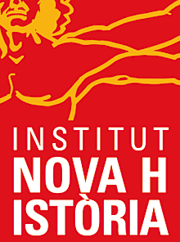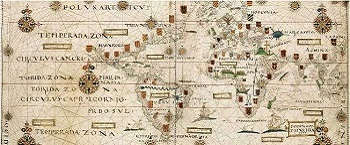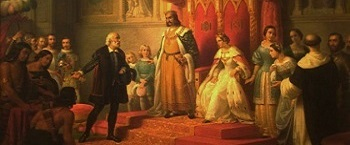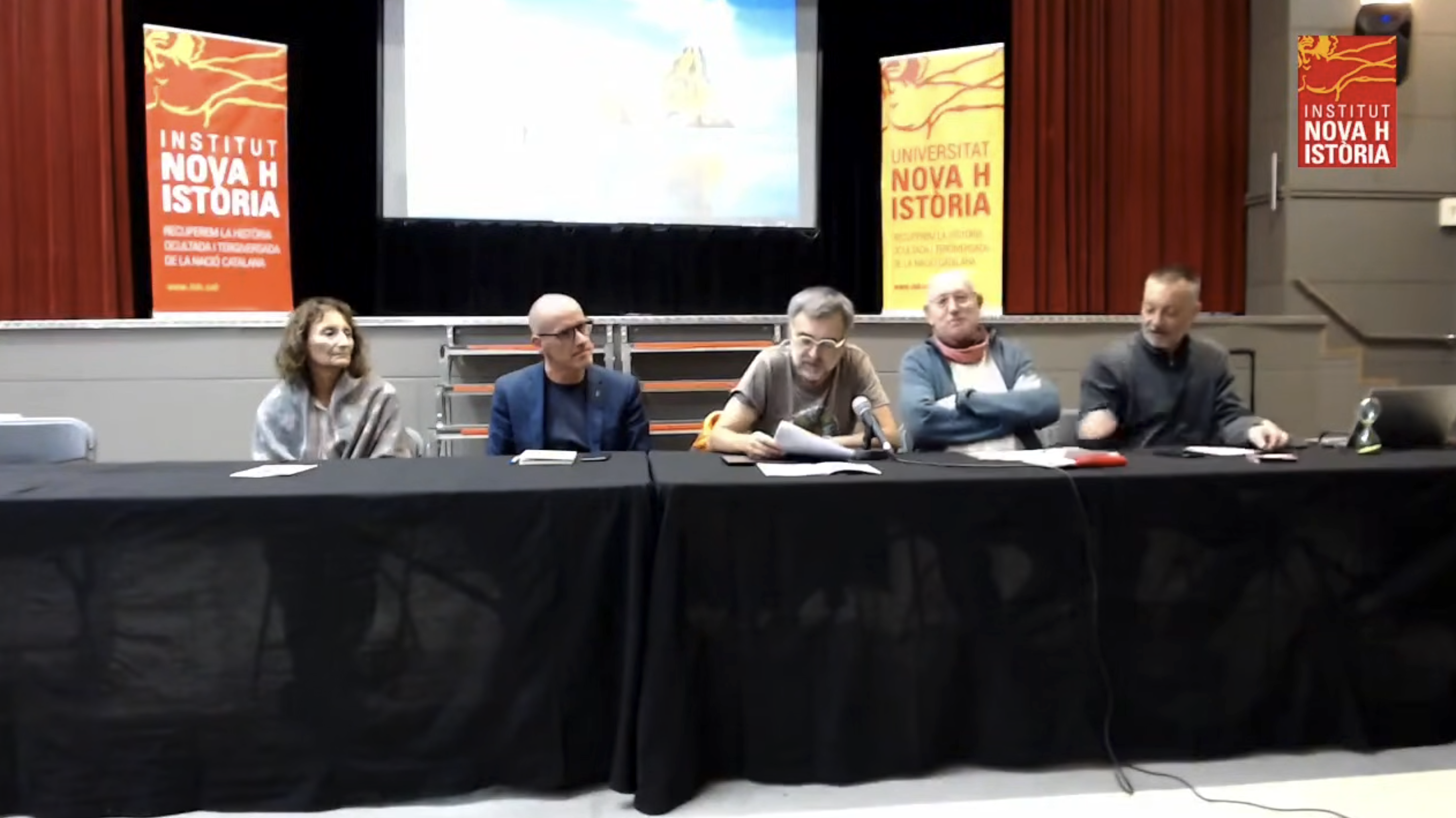Was Christopher Columbus Catalan?
A poc a poc, algunes tesis d’En Bilbeny i l’Institut Nova Història es van internacionalitzant. Sobretot la de la catalanitat d’En Cristòfor Colom i la de la descoberta que la Nació Catalana va dur a terme, des d'una perspectiva europea, de les terres americanes. Avui us fem a mans en la versió original anglesa el resum que, de totes dues tesis, va confegir-ne En Simon Harrys per al seu blog 'Catalonia calling'.
The origins of Christopher Columbus are shrouded in mystery and show characteristics of a political cover-up. What seems extremely clear is that the idea of a humble Genoese wool weaver's son gaining favour with kings and leading an expensive expedition to discover the New World is highly implausible.
Was he Catalan? I am strongly inclined to think so but, although I present all the pro-Catalan arguments here, I have to admit that as far as international historians are concerned the jury is out. However, what might appear to be a slight tangent in the book's argument is worth recounting because it is a clear example of history being rewritten to favour the Castilian oligarchy.
The first time it occurred to me that Christopher Columbus might be Catalan was over 20 years ago whilst reading Robert Hughes' account of the building of the Columbus Monument at the bottom of La Rambla in his immense 'Barcelona', written just prior to the 1992 Barcelona Olympic Games.
"The presence of Columbus - Colom, to give him his Catalan name - requires some explanation today, but in 1882, the year Rius i Taulet commissioned the monument, it was self-evident. Columbus did have connections with Barcelona: he recuperated from his first voyage there and was received by Ferdinand and Isabella, who bestowed on him the plangent title of Almirante del Mar Oceano - Admiral of the Ocean Sea ... Late-nineteenth-century Catalans were convinced, as an article of patriotic faith, that Columbus was Catalan himself. (He was in fact Genoese.) Not only that: he was the Catalan who discovered the New World from whose subsequent plunder by Castile all future Catalans, at least until the time of the indianos, were excluded. It has never been lost on Barcelona that Columbus ... is pointing out to sea with his back towards Castile. Because of the inconvenient configuration of the coast, he is pointing in the general direction of Libya, not America, but the sea is Catalan. In order to reinforce Columbus's incipient catalanisme, the designer ... covered the plinth with ... figures symbolizing the role played by other Catalans in the discovery of America - the Blanes family, for instance, or the priest Bernat de Bol, who went on the Discoverer's second voyage and became the first apostolic vicar of the West Indies."
At the time I paid little attention apart from adding the fact that the Columbus statue was pointing out to Libya to my growing list of Barcelona trivia.
After Dinner Talk
Then a couple of years ago, a friend who had just come back from a holiday in the Caribbean came round for lunch and over coffee started talking about her visit to the British-controlled island of Montserrat. "That was when I realised Columbus had to be Catalan," she exclaimed. "After all, why would a Genoese sailor in the employment of the Crown of Castile call one of his discoveries after a religious mountain in the centre of Catalonia?"
This got us thinking and we quickly came up with Antilles, which loosely translates as 'Before Islands', presumably meaning the islands you come to before you reach the mainland. The word for islands in Catalan is illes whereas it is islas in Spanish. Similarly, the country Argentina uses the Catalan word for silver argent rather than the Spanish plata in its name.
These after-dinner reflections were a long way from solid evidence but my curiosity and been pricked and I decided to look into the Columbus story a little more closely. To my surprise, there was a growing mass of literature on whether Christopher Columbus was Catalan or not.
The Conventional Story
According to legend, Christopher Columbus was born in 1451 in the Italian Republic of Genoa and his Italian name is Cristoforo Colombo while in Spanish he's known as Cristóbal Colón. His father was a humble wool weaver who worked both in Genoa and Savona and who also owned a cheese stand where young Cristoforo worked as a helper.
In 1473, Columbus began his apprenticeship as business agent for the important Centurione, Di Negro and Spinola families of Genoa, and in May 1476 took part in an armed convoy sent by Genoa to carry a valuable cargo to northern Europe. On the trip, he docked in Bristol, England and Galway, Ireland and possibly in Iceland. In the autumn of 1477 Columbus sailed from Galway to Lisbon, where he met up with his brother Bartolomeo, and the two brothers continued trading for the Centurione family.
Apparently, Columbus was intelligent but self-taught and, as a result of his work with merchants and early sea voyages, he became interested in finding an alternative sea route to the Indies and China. In 1485, Columbus presented plans to João II, King of Portugal proposing that the king equip three sturdy ships and grant him a year to sail out into the Atlantic in search of a western route to the Orient.
Columbus also requested he be made "Great Admiral of the Ocean", appointed governor of any and all lands he discovered, and given one-tenth of all revenue from those lands. The story goes that the king submitted Columbus' proposal to his experts, who rejected it because they believed that Columbus' estimation of a travel distance of 2,400 miles was far too low.
On being rebuffed, Columbus sought an audience from the monarchs Fernando II of Aragon and Isabel I of Castile and on 1 May 1486 he presented his plans to Queen Isabel, who also referred them to a committee. After much consideration, the savants of Spain, like their counterparts in Portugal, replied that Columbus had grossly underestimated the distance to Asia. They pronounced the idea impractical and advised their Majesties to pass on the proposed venture.
However, legend has it that after persistent lobbying at the Spanish court and two years of negotiations, Columbus finally had success and in April 1492 at the Capitulations of Santa Fe, King Fernando and Queen Isabel agreed that if he succeeded he would be given the rank of Admiral of the Ocean Sea and appointed hereditary Viceroy and Governor of all the new lands he could claim for Spain.
Columbus would have the right to nominate three persons, from whom the sovereigns would choose one, for any office in the new lands. He would be entitled to 10% of all the revenues from the new lands in perpetuity. Additionally, he would also have the option of buying one-eighth interest in any commercial venture with the new lands and receive one-eighth of the profits.
I have my doubts
This zero to hero story of a poor Genoese wool weavers' son even getting access to, not only one but, two of the most powerful courts in Christendom seems a bit far-fetched to me. Furthermore, not content with having the journey financed and equipped for him, this humble pauper set conditions on the hereditary titles he would receive and how his discoveries would be distributed.
The Columbus of legend had no formal studies yet apparently learnt Latin, Portuguese, and Castilian and there are surviving documents written in all of these but none in Italian or the Genoese dialect. In fact, most of his writings are in Castilian and linguists suggest that they are, in fact, translations from another peninsula language, possibly Catalan or Galician.
For some reason, the story has Columbus born in 1451 but according to his own writings he was already leading maritime expeditions in the 1460s when young Cristoforo Colombo would have only been 15 or 16. Similarly, not only did a commoner get the Catholic kings to finance his expedition and provide him with three ships and crew, most of whom were Spanish not Portuguese or Genoese where he would likely have had more friends, but they also offered him the rank of Admiral and the title of Viceroy and Governor of all the new lands he discovered. Ferdinand and Isabella obviously had a lot of faith in the young Italian's abilities.
Titles such as Viceroy and Governor were only ever given to members of the Castilian or Aragonese nobility, never to foreigners and certainly in Aragon at the time the position of Viceroy, who would rule in the monarch's place, had only ever been given to members of the royal family.
More research
I knew from the description of the plinth of the Columbus Monument in Barcelona that, in the 1880s, the Mayor and the City Council had believed Christopher Columbus and many of his companions to be Catalan. You only have to scratch the surface to find out how common the theory is. The first important publication on the subject was written in 1927 by the Peruvian historian Luis de Ulloa, who claimed that Christopher Columbus was a Catalan named Joan Colom, who after years of captaining pirate vessels established himself in Portugal and changed his name to Xristoferens Colomo.
Since the return of democracy in 1975, there have been other studies including a comparison of the Coats of Arms of the noble Barcelona family of Colom i Bertran and the official Coat of Arms of Christopher Columbus and both were found to include stripes, a rampant lion and a globe with a cross on top but the dove present on the Colom i Bertran Coat of Arms was missing the Columbus crest.
Coincidentally, the word dove is translated as colom in Catalan and according to testimonies in the court cases that the Columbus family brought against the Spanish monarchs for breaking their word on the hereditary titles promised at the Capitulations of Santa Fe, was initially present on the Columbus Coat of Arms.
However, it was removed by Castilian censors in later versions presumably because it would have given away Columbus' true identity.
In 1976, another study showed that the four Colom Bertran brothers, Guillem, Francesc, Joan and Lluís, were clearly contemporaries of the Admiral. However, it wasn't until 1999 that the researchers from the Institut Nova Història led by Jordi Bilbeny began to pull the various threads together into a coherent whole. What follows is a much simplified version of the conclusions but gives a reasonably clear idea of their claims.
Joan Colom i Bertran
According to Bilbeny and his team, Christopher Columbus' real name was Joan Colom i Bertran from a Barcelona family of high-ranking religious or military men, navigators, cosmographers or merchants with access to the Court. His brothers, Francesc and Lluís were President of the Generalitat and a sea-captain respectively so the family had important political connections and maritime experience. Joan Colom had more brothers and sisters including Jaume, Guillem, Elionor, Isabel and Beatriu. All these names also appear in the official Christopher Columbus' family tree in their castilianised versions. Furthermore, Joan Colom had a son called Jaume whilst Columbus' son was called Diego, which is the medieval translation of Jaume in Castilian.
Joan Colom was born in 1424 and married twice. His first wife was Margarida d'Alós, with whom he had three sons, and his second Felipa de Coimbra, who was daughter of Pere of Portugal and of Elisabet of Urgell, which made her granddaughter of Jaume of Urgell, the failed Catalan pretender to the Aragonese throne.
Joan Colom had been a military leader on the side of the Generalitat in the Catalan Civil War against Fernando the Catholic's father Juan the Faithless during which time the Catalans had made Pere of Portugal their king. Following the defeat, Joan escaped and led pirate attacks off the coast of Catalonia on military and merchant targets before ending up in the service of Louis XI of France for whom he led expeditions into the Arctic. It seems very likely the Joan Colom would have visited North America so he knew of the existence of another continent across the Atalantic and reasoned that the rich pickings would be further south. This was why he could be so confident in his demands to the Portuguese and Spanish monarchs.
In the 1480s, Joan Colom wound up at the Potuguese court where he fell in love with Felipa, the sister of his deceased former ally, Pere of Portugal. They had a son called Ferran, who as great-grandson of Jaume of Urgell would have definitely had a claim to the throne of Aragon. Incidentally, Ferran is translated as Fernando or Hernando in Castilian and sure enough, the official Christopher Columbus had a son called Hernando.
For patriotic reasons, Joan Colom wanted to lead his expedition to the New World from Catalonia and, taking advantage of the amnesty for participants in the Civil War, installed himself in the port of Pals on the coast of Northern Catalonia. Negotiations began mainly with Fernando of Aragon in order to guarantee the benefits and hereditary titles, which would allow Colom to establish what would effectively be a new royal family in the New World. In return, Bilbeny suggests, Colom would have renounced his son Ferran's claims to the throne of the Crown of Aragon.
In August 1492, the expedition set sail from the Catalan port of Pals. The Spanish version claims Columbus embarked from Palos de la Frontera in Andalusia but recent studies show that as today, its port, which is set on a river estuary, was certainly not big enough to moor three large ocean-going ships. Furthermore, many of Columbus' companions are documented as living in the Empordà region of Catalonia and of being known to the Colom i Bertran family. The best example is the famous Yañes Pinzón brothers who in Catalan were Anes Pinçon.
In early engravings, most of the flags the ships carry bear stripes just like the Catalan senyera whilst the Castilian flag showing the picture of a castle is suspiciously absent. The flags cannot be Spanish flags because the red stripes on the gold background of the rojigualda wasn't invented until 1785. Incidentally, when you stop and think about it, the Spanish flag looks much more like the Catalan senyera than it does the Castilian flag. Perhaps the design was chosen to protect Castilian territorial claims to the Americas.
Censorship
There is so much evidence that Columbus and Colom were the same person and the reasons why the story was changed are pretty obvious. Colom's descendants were of royal descent and as soon as the Catholic Kings realised how much power they had given away at the Capitulations of Santa Fe and the size and wealth of the new territory, they knew they had made a mistake.
Fernando, in particular, was autocratic enough to have introduced the Inquisition so they would have had few qualms about breaking their deal with some rebellious Catalan nobles. Furthermore, the printing press was just beginning to come to centre stage and someone as capable as Fernando would have realised the power of propaganda. Unfortunately, the censors left traces of the cover-up and eagle-eyed researchers can still find them to this day.
The only remaining question is why did a Barcelona noble called Joan change his name to Christopher or Cristòfor in Catalan. The answer is simple. These were religious times and the current pope was the Valencian Alexander VI of the Borja family, who as a Catalan speaker would have known Joan Colom. The reason for the expedition wasn't only commercial but was to take Christianity across the water just as Saint Christopher had carried Jesus across the river in the Bible tale.
An interesting footnote to Catalan Columbus mystery came in 2011 when Spanish researchers collected the DNA of the families of the various claimants and the plan was to make a comparison with the DNA of Hernando Colón whose body lies in Seville Cathedral. As the research was drawing to a close, lead investigator Dr José Antonio Lorente was interviewed on Catalan TV and said that the Catalan hypothesis looked the most likely. Mysteriously, the research was never heard of again and the results still haven't been published.

24 September 2014 @ 13:23
From blog ‘Catalonia Calling’
Simon Harrys
https://www.eyeonspain.com/blogs/cataloniacalling/13795/Was-Christopher-Columbus-Catalan.aspx
Autor: Simon Harrys








